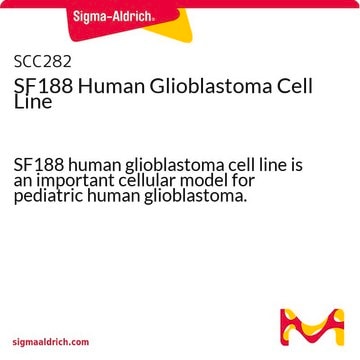SCC126M
SF7761 Human DIPG H3.3-K27M Cell Line
Human
Synonym(e):
Diffuse intrinsic pontine glioma cells
About This Item
Empfohlene Produkte
product name
SF7761 Human DIPG H3.3-K27M Cell Line, SF7761 pediatric diffuse intrinsic pontine glioma (DIPG) cell line harbors the histone H3.3 Lys 27-to-methionine (K27M) mutation and can support research and drug development efforts targeting DIPG.
Biologische Quelle
human
Qualitätsniveau
Methode(n)
cell culture | mammalian: suitable
Allgemeine Beschreibung
A somatic mutation of histone H3.3 resulting in a lysine 27 to methionine substitution (H3.3K27M) occurs in 60% of DIPG . In H3.3K27M DIPG patient samples, levels of H3K27 dimethylation (H3K27me2) and trimethylation (H3K27me3) are reduced globally. Expression of H3.3K27M was also shown to be associated with increased levels of H3K27 acetylation (H3K27ac) and recruitment of bromodomain proteins at sites of active transcription . These epigenetic changes are thought to be important factors driving DIPG oncogenesis
IMPORTANT NOTE: SF7761 are grown as neurospheres in suspension culture. Neurospheres are to be passaged using gentle mechanical trituration when they reach diameters of 200-500 um or through enzymatic dissociation.
Beschreibung der Zelllinie
Anwendung
Cancer
Oncology
Qualität
• Cells are tested negative for HPV-16, HPV-18, Hepatitis A, C, Herpesvirus type 6, 7, 8 and HIV-1 & 2 viruses by PCR.
• Cells are negative for mycoplasma contamination.
• Each lot of cells is genotyped by STR analysis to verify the unique identity of the cell line.
Lagerung und Haltbarkeit
Lagerklassenschlüssel
12 - Non Combustible Liquids
WGK
WGK 2
Flammpunkt (°F)
Not applicable
Flammpunkt (°C)
Not applicable
Analysenzertifikate (COA)
Suchen Sie nach Analysenzertifikate (COA), indem Sie die Lot-/Chargennummer des Produkts eingeben. Lot- und Chargennummern sind auf dem Produktetikett hinter den Wörtern ‘Lot’ oder ‘Batch’ (Lot oder Charge) zu finden.
Besitzen Sie dieses Produkt bereits?
In der Dokumentenbibliothek finden Sie die Dokumentation zu den Produkten, die Sie kürzlich erworben haben.
Unser Team von Wissenschaftlern verfügt über Erfahrung in allen Forschungsbereichen einschließlich Life Science, Materialwissenschaften, chemischer Synthese, Chromatographie, Analytik und vielen mehr..
Setzen Sie sich mit dem technischen Dienst in Verbindung.








